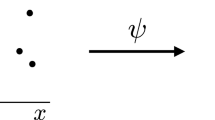Abstract
The property producing a field has a qualitative and a quantitative aspect. The former may appear as1, 2, 3,..., n possibilities in the source particles. Interaction lines representing the field must reflect these possibilities. Thus, one expects there to be1, 2, 3,..., n respective kinds of lines joining particles. The different lines interact with each other as well as with the particles at their ends. For gravitational fields,n is1; for electromagnetic fields,n is2; for chromodynamic fieldsn is3. Rest mass can be created by itself out of energy. But a positive-negative pair is the minimum possibility with electric charges, and a color-anticolor pair with quarks. A triplet of quarks or antiquarks, together with the appropriate neutrino, could also arise out of energy.
Similar content being viewed by others
References
M. B. Hesse,Forces and Fields (Philosophical Library, New York, 1961), pp. 189–225.
Particle Data Group,Rev. Mod. Phys. 52, S1-S286 (1980).
W. Band,Introduction to Mathematical Physics (D. van Nostrand, Princeton, 1959), pp. 170–176.
J. Jeans,The Mathematical Theory of Electricity and Magnetism (Cambridge University Press, Cambridge, 1948), pp. 24–65, 369–371.
V. I. Zakharov, B. L. Ioffe, and L. B. Okun,Sov. Phys.—Usp. 18, 757–803 (1976).
M. Jammer,Concepts of Force (Harvard University Press, Cambridge, Mass., 1957), pp. 116–146.
I. S. Shapiro,Sov. Phys.—Usp. 15, 651–659 (1973).
J. C. Maxwell,A Treatise on Electricity and Magnetism, 3rd ed. (Academic Reprints, Stanford, 1953), Vol. 1, p. ix.
J. R. Reitz and F. J. Milford,Foundations of Electromagnetic Theory (Addison-Wesley, Reading, Mass., 1960), pp. 25–27, 199–201.
A. Salam,Rev. Mod. Phys. 52, 525–538 (1980).
G. H. Duffey,Theoretical Physics: Classical and Modern Views (Robert E. Krieger, Huntington, N.Y., 1980), pp. 57–61.
J. D. Jackson,Classical Electrodynamics (Wiley, New York, 1962), pp. 4–9.
B. Sheehy and H. von Baeyer,Am. J. Phys. 49, 429–431 (1981).
Author information
Authors and Affiliations
Rights and permissions
About this article
Cite this article
Duffey, G.H. Interaction-line descriptions of fields. Found Phys 12, 499–508 (1982). https://doi.org/10.1007/BF00729997
Received:
Issue Date:
DOI: https://doi.org/10.1007/BF00729997



